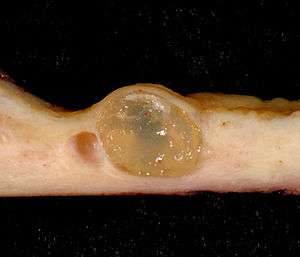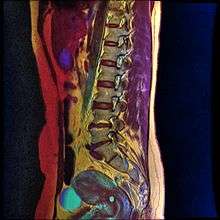Nabothian cyst
A nabothian cyst (or nabothian follicle)[1] is a mucus-filled cyst on the surface of the cervix. They are most often caused when stratified squamous epithelium of the ectocervix (portion nearest to the vagina) grows over the simple columnar epithelium of the endocervix (portion nearest to the uterus). This tissue growth can block the cervical crypts (subdermal pockets usually 2–10 mm in diameter), trapping cervical mucus inside the crypts.
| Nabothian cyst | |
|---|---|
 | |
| Nabothian cyst | |
| Specialty | Obstetrics and gynaecology |
Presentation
Nabothian cysts appear most often as firm bumps on the cervix's surface. A woman may notice the cyst when inserting a diaphragm or cervical cap, or when checking the cervix as part of fertility awareness.[2] A health care provider may notice the cysts during a pelvic exam.
Diagnosis
If a cyst has an unusual appearance, a colposcopy will be performed to rule out other diagnoses.[3] If the blood vessels are short, comma-like or corkscrew-shaped and bleed on contact, then the cyst may be a very rare mucin-producing carcinoma of the cervix.[3] Magnetic resonance imaging is used to distinguish cancer from the typical nabothian cyst.[3]
Treatment

Nabothian cysts usually require no treatment and frequently resolve on their own.[3] Cryotherapy has been used to treat nabothian cysts but is rarely necessary.[3] Very rarely a cyst may be so large that it prevents a clinician from performing a pap smear, in which case the clinician may puncture the cyst with a needle and drain it.[3] If nabothian cysts occur with chronic cervicitis (inflammation of the cervix) then the underlying cause of the inflammation must be treated.[4]
Eponym
Nabothian cysts are also known as nabothian follicles, mucinous retention cysts, or epithelial inclusion cysts. They are named after German anatomist Martin Naboth (1675–1721), who wrote about them in a 1707 treatise titled De sterilitate mulierum. However, they were earlier described by French surgeon Guillaume Desnoues (1650–1735).[5] Since it is a derived term, nabothian is not spelled with a capital first letter.
See also
References
- "Dorlands Medical Dictionary:nabothian follicles".
- Weschler, Toni (2002). Taking Charge of Your Fertility (Revised ed.). New York: HarperCollins. pp. 227–228, 330. ISBN 0-06-093764-5.
- Women's gynecologic health. Schuiling, Kerri Durnell., Likis, Frances E. Sudbury, Mass.: Jones and Bartlett. 2006. p. 570. ISBN 0763747173. OCLC 57731391.CS1 maint: others (link)
- Adam., Ostrzenski, (2002). Gynecology : integrating conventional, complementary, and natural alternative therapy. Philadelphia: Lippincott Williams & Wilkins. p. 235. ISBN 0781727618. OCLC 47013933.CS1 maint: extra punctuation (link)
- "Nabothian Cysts". Who Named It?. 2007. Retrieved 2007-06-22.
External links
| Classification | |
|---|---|
| External resources |